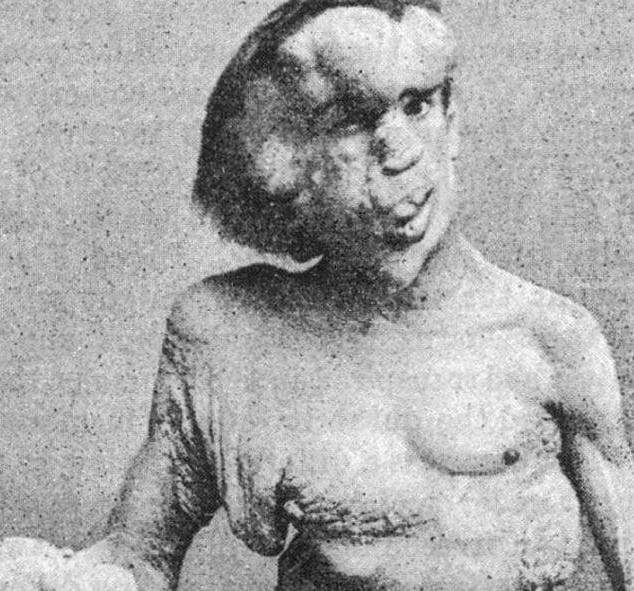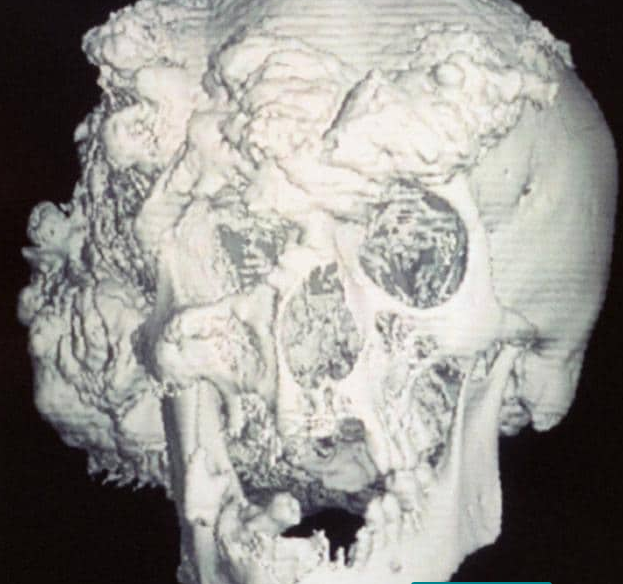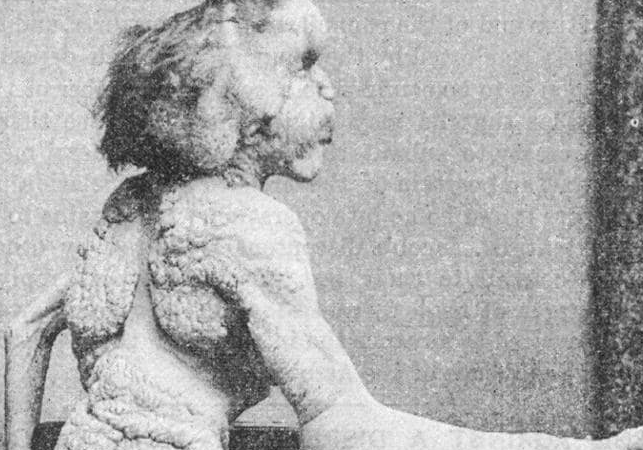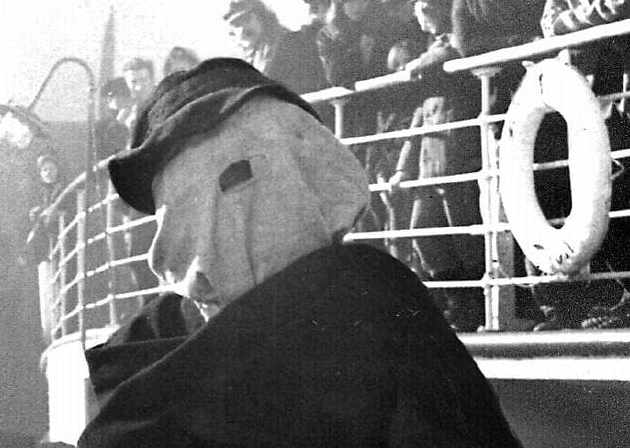When Joseph Merrick began to grow a ?trunk? on his face, he became a household name. But his story is only just reaching a conclusion.
With his ?trunk-like? facial growth, curved spine and enormous misshapen skull, the ?Elephant Man? was the main attraction at London sideshows, the star of the so-called freakshows popular in the Victorian period.
While most of the people paraded on stage as part of the shows had a tragic story ? of disability, abandonment and homelessness ? Merrick?s tale is perhaps the most upsetting story of all.
From a young age, Merrick had developed scoliosis, skull bone outgrowth, with skin protruding from his face and an overgrown right arm.
He came to be known as the Elephant Man due to the skin on his face.
His facial deformities led people to see Merrick as a ?monster? and a threat to society. But the opposite was true. He was said to be a kind and gentle man trying to survive in a society that didn?t care for him, aside from a few people who tried to help him.
Since his death, Merrick?s extreme deformities have made him the intriguing subject of posthumous film and stage productions, exploring the man who was trapped inside a deformed body.
David Lynch?s 1980 film Elephant Man, starring John Hurt as Merrick, is credited for being the closest depiction of his life, where we are able to see a glimpse of the heart of the man who had been cruelly labelled a monster.
Merrick died 129 years ago and today there?s a new reason to remember him, with the discovery last month of his grave ? in the same cemetery where two of Jack the Ripper?s victims were laid to rest.
Officials in the U.K. placed a plaque at the newly discovered gravesite more than a century after he died.
Merrick?s remains were buried on April 24, 1890. Their precise whereabouts were unknown until Joanne Vigor-Mungovin, author of Joseph: The Life, Times & Places of the Elephant Man, recently traced them to the London Cemetery.
Now, his story lives on.
 Joseph Carey Merrick, English man with very severe deformities known as the ?Elephant Man? in 1889. Picture: Alamy Source:Alamy
Joseph Carey Merrick, English man with very severe deformities known as the ?Elephant Man? in 1889. Picture: Alamy Source:Alamy
THE EARLY YEARS
Born August 5, 1862 Joseph Merrick was a healthy baby until the age of 21 months when his lips began to swell. This was followed by the development of a bony lump on his forehead, which later grew. The skin on his face also grew and became very loose.
By the age of five he was showing more extreme signs of deformities; his right arm was at least twice the size of his left arm and his feet were also enlarged and deformed.
As he grew older, his skin thickened and he developed several large growths on various parts of his body.
As a child, Merrick was told that his condition was caused by his mother, Mary Jane, being frightened by an elephant she?d seen at a fairground when she was pregnant.
There are two medical conditions that have been considered for Merrick; Proteus syndrome, a rare disease that causes overgrowth of the bones as well as the skin.
There?s another theory that he had neurofibromatosis, a genetic disorder that causes tumours on nerve tissues, which then spreads to the brain and the spine.
 Joseph Merrick was a healthy baby until the age of 21 months when his lips began to swell. Picture: Alamy Source:Alamy
Joseph Merrick was a healthy baby until the age of 21 months when his lips began to swell. Picture: Alamy Source:Alamy
A TERRIBLE CHILDHOOD
One of the worst things that happened to Merrick was the death of his beloved mother Mary Jane. She died of pneumonia when Merrick was just 11 and he was said to be devastated. Mary Jane was handicapped herself and three other children had died before Merrick was born.
Merrick?s father (also named Joseph) remarried, but his new stepmother didn?t want Merrick in the house and she demanded the child leave school at 13 and earn a living.
It was an awful childhood for the handicapped boy.
As his deformities got worse, he managed to find a job at a cigar shop, but it became too difficult for him to do the fiddly job of rolling cigars with his large right hand.
His father arranged a hawker?s license so the boy could sell gloves as a door-to-door salesman. But his appearance frightened potential customers and he struggled to make any money.
Joseph Senior was said to be a very cruel man, beating the boy if he came home with no money. His stepmother would refuse to give the boy any food until he?d made enough money to pay for his keep.
He was so miserable at home, he ran away several times. Luckily there was one kind person in his life, his uncle Charles Merrick who let him live with him and tried to help him with his business selling gloves. But his licence was revoked after a couple of years due to customers being scared of him.
At 17, and with no way to support himself, Merrick was forced to go to the dreaded Leicester workhouse.
 The skull of Joseph Merrick. Picture: Alamy
The skull of Joseph Merrick. Picture: Alamy
A WORKHOUSE & THE FREAKSHOW
The workhouse system was a notorious Victorian institution for the poor and destitute. It was unspeakably cruel and a tough place to be even for an able-bodied person. Merrick was forced to spend five years in what was said to be a hellhole.
According to Steve Moore, who manages Merrick?s skeleton at the Queen Mary University of London, the teenager was desperate to escape the workhouse.
?It was so awful, he felt the only way to make money was to join the circus. He contacted showman Tom Norman, and went to London to star in his freak shows,? Moore said.
?There has been a lot of debate about whether Norman was using or abusing Merrick. Merrick made a lot of money starring in the shows, but Norman made more. Whatever the truth, Merrick never experienced freedom.?
At first people believed Merrick was mentally handicapped, but that was far from the truth as he managed to teach himself to read and write. But he wasn?t able to speak due to his facial deformities.
The young man was forced to survive in the most harrowing conditions. At one stage he was living on his own and slept in a shop, with only a single flame for heat, in the middle of a brutal British winter.
Due to his facial deformities he struggled to eat and he had absolutely nobody to help him.
?Just think about the quality of food that he would have eaten, and the difficulty that he would have had eating it. You or I would have gone mad with frustration,? Moore said.
During the mid-late 1800s thousands of Londoners would flock to freakshows to gawk at the people modern society had rejected ? the disabled, the fat, the tall, the bearded ladies, Siamese twins ? but nobody had a person onstage quite as incredible as ?The Elephant Man.?
He was promoted as being ?half man, half elephant,? but the only similarity to an elephant was the skin protruding from his face like a trunk.
On stage, Merrick displayed his increasingly misshapen body; he?d become a huge ?freak show? sensation. But, his health was rapidly declining.
A NEW HOPE
As Merrick was working on the sideshow, he lived near the London hospital and, thankfully, he came to the attention of surgeon Frederick Treves, who was intrigued about the ?Elephant Man? and asked if he could inspect Merrick?s body.
Merrick agreed and Treves found Merrick?s deformities were incredibly extreme ? there were bony protrusions and soft-tissue swellings covering much of his body and he was also suffering from physical and psychological pain.
His body was riddled with tumours and his leg had worsened to a stage where he could only walk with a cane. The only time Merrick went outside, he?d cover himself with a cape and hood, in a desperate attempt to avoid people staring at him.
One thing Treves took away from his meeting with Merrick was the fact that the young man was a person to be admired; a survivor.
Treves stayed in touch with Merrick, even after the freak show closed in London and moved to Belgium. But life in Belgium was even worse than London. Merrick?s new manager abandoned him, and he was robbed and left homeless in a country where he knew nobody.
He managed to get himself back to England where he went to see the one person he felt truly cared about him; Dr Treves.
By the age of 24, Merrick?s health had deteriorated, and Treves made sure he was able to live at the hospital. He also set up a fund for people to donate to the special medical care he required. During the four years he spent at London Hospital, Merrick was visited by several famous people from the theatre, people keen to show their support for the man so many had used for entertainment. By then, public opinion had turned against freak shows which were seen as unnecessary and cruel.
Merrick died in his hospital bed on April 11, 1890. It?s believed he?d tried to sleep lying down on his bed, which caused his head to fall at an angle that dislocated his neck. The official cause of death was recorded as asphyxia.
While much of Merrick?s 27 years of life were dominated by cruelty and inhuman treatment, at least his final four years were said to be peaceful and comfortable.
 Joseph Carey Merrick as a child. Exact date unknown.Source:Alamy
Joseph Carey Merrick as a child. Exact date unknown.Source:Alamy
MERRICK?S GRAVE
When author Joanne Vigor-Mungovin was researching her book, Joseph: The Life, Times and Places of the Elephant Man, she had heard of a story that part of Merrick?s remains were buried somewhere while his skeleton was preserved at Queen Mary University of London.
She wasn?t actively looking for it until a friend told her about a woman who, each year, places a bottle of gin on the grave of Jack the Ripper victim Catherine Eddowes, who is buried at the City of London Cemetery and Crematorium in Newham (another Ripper victim, Polly Nichols, is also buried there).
The Ripper was active in 1888 while Merrick died in 1890 so it made sense they could be buried in the same cemetery.
 Joseph Merrick?s grave. Picture: City of London Corporation
Joseph Merrick?s grave. Picture: City of London Corporation
Vigor-Mungovin told me that it was a huge shock to see Merrick?s name in the burial records ? which had his address listed as London Hospital, where he spent his final years.
?After realising that the record I was looking at was Joseph I went down to London where was shown the actual book with his burial record in and the map with the plots. Then it started to sink in,? Vigor-Mungovin said.
?Looking at that old Victorian handwriting and knowing that someone sat there and wrote his name started to send shivers up my spine, I was looking at a piece of history.
?I then started to feel a bit emotional. I bought a posy of flowers from the florist and laid them on his plot. I said a little prayer and that was it.?
?As a researcher it was a great find, but because I?ve spent so long looking into his life, his family and how he lived, I felt I?d found a friend. I had this inner calm knowing that he had a Christian burial and was laid to rest in consecrated ground.
?Bones or no bones, Joseph is at peace.?
Vigor-Mungovin, who also discovered she is related to Tom Norman, the showman who looked after Joseph whilst he exhibited himself in London, wants to see Merrick honoured in his home town with a statue.
?He was more than a freak show. Those who met him saw beyond his deformities, as I did when I wrote my book. I focused more on the man, not on his condition. He was an educated young man with an inquisitive mind.
?Joseph had the ability to make good judgements and make quick decisions which saw him turn his disadvantage to a great advantage.,? Vigor-Mungovin said.
?Knowing now that Joseph rests in peace and has a burial site does not end his story. But hopefully it will be the start of the true story of Joseph Carey Merrick.?
 Actor John Hurt as Joseph Carey Merrick (known as The Elephant Man) in a scene from the 1980 film ?The Elephant Man?
Actor John Hurt as Joseph Carey Merrick (known as The Elephant Man) in a scene from the 1980 film ?The Elephant Man?

